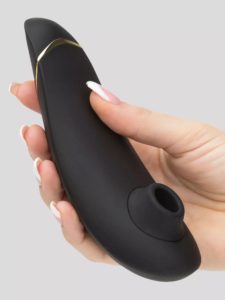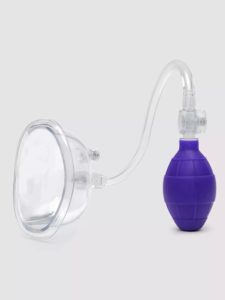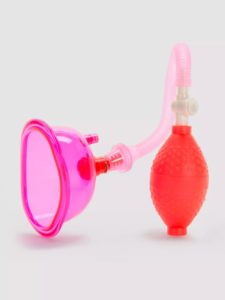Advertising disclosure: This content contains affiliate links and sponsored product placements. That means that if you make a purchase through one of these links, we receive a commission. See our Advertising Disclosure page for more info.
Table of Contents
I recently had the following question from a reader:
“I’m a woman and beginning to have more trouble getting aroused with a partner or even climaxing using a stimulator. As I age, will my orgasms be fewer and fewer? I have done a little research and wanted your opinion on clitoris pumps.”
There are two good questions here: one about orgasms and aging, the other about clitoral pumps. Today I am going to talk about the latter, clitoral pumps. The former will be addressed in the future.
The complex structure of the clitoris
The clitoris is a complex structure—the woman’s most sensitive erogenous zone and the primary anatomical source of female sexual pleasure. The head of the clitoris, located in the midline just inside the labia minora, the small inner lips of the external genitalia, is about the size of a pea and covered with thousands of sensory nerve endings.
Only in the last decades has investigation shown that the clitoris is far more than a “bud” or a “button.” The internal structure is shaped like a wishbone. The arms of the clitoris (shaped like a wishbone) extend downward from the head just under the skin of the inside side of the labia minora, down around the urethra toward the vaginal opening and up into the anterior wall of the lower third of the vagina.
These arms as well as the head of the clitoris contain erectile tissue. With sexual excitement the erectile tissue fills with blood, thus distending the overlying skin, which magnifies the sensitivity of the sensory nerve endings.
Tactile stimulation of not only the head but also the small inner lips of the labia, and the anterior wall of the lower third of the vagina with a lubricated finger, the tongue, the penis or a sex toy, creates the sexual response often leading to orgasm.
The effects of aging on clitoral response
So what happens with aging? Hardening of the arteries, diabetes and other age-related illnesses become more common. These can reduce arterial blood flow to the clitoris, which, in turn, reduces distention, sensitivity, sexual pleasure, and the ability to reach orgasm.
Finding ways to increase arterial blood flow, such as regular sex, self pleasuring and using sex toys like vibrators and clitoral pumps, are all good ways to maintain adequate blood flow and function for your genital and sexual health.
What is a clit pump?
Clitoral pumps create a vacuum that uses suction to draw blood into the clitoris. They are similar in function to penis pumps and work on the same principle. They have a hand pump to create a vacuum, and a cup that is placed over the clitoris or labia.
The cups come in various shapes and sizes. The smaller devices are intended only for clitoral suction while the larger sizes are used for clitoral and labial suction. Some models have ribs or nubs in the cup to increase stimulation.
Adding a clitoral pump to foreplay increases blood flow to the clitoris which enhances sexual satisfaction and increases the likelihood of orgasm with intercourse.
Clitoral pumps are not to be confused with clitoral vibrators, which are designed for stimulating the clitoris to enhance sexual response. Vibrators do not create a vacuum to increase blood flow to the clitoris. They do have in common enhanced sexual response, but by different mechanisms.
Clitoral pumps and clitoral vibrators can be used serially. First, the pump is used to increase blood flow to the clitoris, engorging it and sensitizing its nerve endings. A clitoral vibrator is then used for achieving orgasm.
There is a newer type of clitoral stimulator on the market that is sometimes confused with clitoral pumps. These stimulators use air to create a feeling of suction around the clitoris (like a sucking sensation), but don’t create a vacuum-like pump. The Womanizer line is the best known. Some women find they reach orgasm more quickly and reliably with a suction clitoral stimulator rather than a standard clitoral vibrator.
What are some examples of clitoral pumps and similar devices?
What is the take-home message?
- Hardening of the arteries, diabetes, and other age-related illnesses can reduce pelvic and genital blood flow, negatively affecting sexual function.
- The clitoral pump is another tool to maintain pelvic and genital blood flow, and enhance sexual responsiveness and sexual pleasure, as does regular intercourse, self-pleasuring, and/or the use of other sex toys.
- The clitoris is the preferred site for female sexual pleasure. There is a great diversity in the preferred stimulation and technique—every woman is different. Through trial, find whatever works best for you. It’s worth the effort.
Thank you for coming to our website. Please keep the questions coming using our Ask the Expert feature.
As per our Terms of Use, this article is for general educational and informational purposes only and is not meant to serve as a substitute for professional medical advice. Consult with your own physician or health care practitioner regarding the use of any information received here before using or relying on it. Your physician or healthcare practitioner should address any and all medical questions, concerns, and decisions regarding the possible treatment of any medical condition.
References
- Boston University School of Medicine, Female Genital Anatomy
- Healthline.com, Everything You Should Know About Your Clitoral Hood








